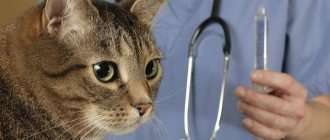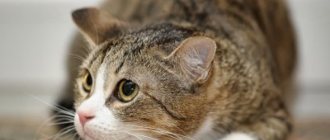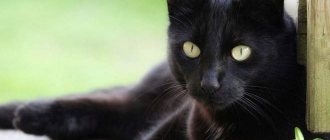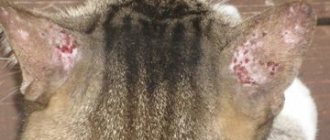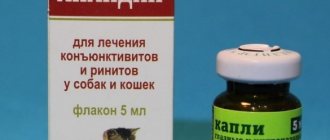A condition such as anorexia in cats has several causes and varieties, and is accompanied by sudden weight loss and appetite disorder. At the first symptoms, the owner should take the pet to a veterinarian, who will determine the cause of the pathological condition, prescribe effective treatment and give recommendations on proper nutrition for the pet.
According to veterinarians, prolonged anorexia is dangerous due to the development of liver lipidosis, which leads to liver failure and death.
What is anorexia?
Anorexia is a decrease or loss of appetite in a cat.
While the mechanism of hunger is determined by physiology, appetite is determined by psychological processes. There are two types of anorexia: true anorexia and “pseudo-anorexia”. Both result in decreased food intake, but a cat with pseudoanorexia wants to eat (is hungry) but cannot because it has difficulty grasping, chewing, or swallowing food or there is another reason (see below).
Whether a cat has a true loss of appetite or pseudoanorexia, hyporexia or decreased food intake are outward signs that should be taken seriously.
These signs may indicate potentially life-threatening underlying conditions. Poor appetite or refusal to eat is highly correlated with illness and is a common reason for cat owners to seek veterinary care.
“Decreased appetite and reduced food intake may indicate the presence of potentially life-threatening illnesses and should be taken seriously by the cat owner.”
When is it necessary to go to the doctor?
Be sure to consult a veterinarian if your pet has poor appetite if additional adverse symptoms are present:
- repeated vomiting;
- loose frequent stools, especially with blood;
- decreased general tone, apathy;
- complete refusal of water;
- ineffective intermittent urge to urinate or defecate;
- pain in the abdominal cavity;
- bloated belly;
- sneezing, drooling, discharge from the eyes;
- formation of dry, painful crusts on the nose and around the mouth;
- feverish condition.
What causes anorexia and pseudoanorexia?
There are many possible explanations for decreased food intake, and the first, most important step is to determine whether the cat has true anorexia or pseudoanorexia. Does the animal really want to eat, but cannot, or is there really no interest in feeding? The veterinarian will take a detailed history to differentiate between the two conditions. A thorough medical examination of your cat will then be performed to determine if there is an obvious physical explanation for the decreased food intake. Finally, diagnostic tests will be used to identify the cause of your decreased appetite.
These may include laboratory tests such as a complete blood count (CBC) and serum chemistry profile, electrolytes (mineral balance), radiographs (chest and abdomen x-rays), ultrasound examinations and (depending on other results) may be used more invasive diagnostics such as endoscopy or biopsy.
Possible explanations for pseudoanorexia, in which a cat wants to eat but is unable to do so or has difficulty eating, include:
- Stomatitis, gingivitis or esophagitis is inflammation and pain in the tissues of the mouth, esophagus and pharynx.
- Progressive periodontal disease, which may include loose teeth.
- Abscess in the eye area.
- Pain in the masticatory muscles.
- Pain in the temporomandibular joint (TMJ).
- Disease of the salivary glands.
- Diseases of the nervous system affecting chewing and swallowing.
- Cancer/tumors of the mouth, tongue, tonsils or related structures.
- Pain anywhere in the body.
Chronic pain is very distracting. This may affect the cat's appetite or ability to reach food and water on the floor if, for example, the cat is experiencing back pain.
True anorexia can also have various causes:
- Systemic disease, whether infection or organ system dysfunction, which can lead to anorexia.
- Psychological explanations such as stress, altered care and maintenance routines, changes in the environment, or unwanted/unpleasant food.
- Exposure to poisons.
- Immune system imbalance/disease.
- Loss and reduction of sense of smell. Aroma is an important factor influencing food taste and appetite.
- Any painful condition can suppress your appetite.
- Cancer of all types.
- Gastrointestinal blockage by a foreign body.
- Peptic ulcer of the stomach or intestines.
- Nausea from any reason.
- High ambient temperature.
- Drug side effects.
Symptoms of food refusal
Sometimes a busy owner does not immediately notice that the cat is not eating well, but inevitably sooner or later he will pay attention to other additional factors:
- lethargy and apathy of the animal;
- increased gas formation and abdominal bloating;
- poor coat condition;
- dyspepsia – vomiting, diarrhea or constipation;
- bad breath;
- the presence of blood and mucus in stool and vomit;
- thinning and bluish skin;
- cardiopalmus;
- difficulty breathing and shortness of breath;
- "acute" stomach;
- loss of consciousness.
It is necessary to be attentive to your pet and respond to any change in the cat’s appetite. After all, this may be the beginning of a serious illness, which is easiest to cure at the very beginning.
How are anorexia and pseudoanorexia treated?
“To treat decreased food intake, whether it is true anorexia or pseudoanorexia, it is very important to identify and correct the underlying problem.”
To treat decreased food intake, whether true anorexia or pseudoanorexia, it is important to identify and correct the underlying problem. This part of the treatment will depend entirely on the diagnosis. Concomitant or additional treatment will focus on managing/treating associated symptoms and complications. For example, if the cat is dehydrated, intravenous fluids may be required.
Any nausea should be eliminated. If appropriate, your veterinarian may prescribe a short-term appetite stimulant such as cyproheptadine or mirtazapine. If there is a mineral imbalance, such as low potassium levels, that may interfere with normal appetite, then a potassium supplement is added. This may be useful in improving the taste of cat food. Your veterinarian can help you with specific recommendations, but try these simple steps:
- Adding canned formula to the diet.
- Warming food to approximately body temperature (38°C).
- Add some low-sodium chicken, vegetable, or beef broth to enhance the flavor.
- Temporarily, you can use food from the owner's table, prepared according to appropriate recipes under the guidance of your veterinarian.
Sometimes an anorectic cat who has an underlying metabolic disorder needs to get nutrients but does not want to eat. In these cases, your veterinarian may place a feeding tube into the esophagus, stomach, or small intestine through a small cut in the skin. Feeding tubes in general are almost always life-saving. Food and medications can be delivered with minimal stress to the cat.
If the gastrointestinal system is capable of digesting food, it should be used, even if it involves delivering food through a tube for a period of time. If the GI system is not working for any reason, your veterinarian may recommend something called parenteral nutrition, in which nutrition is given intravenously.
Parenteral nutrition is a specialized, complex technique usually performed by a critical care specialist. Tube feeding and parenteral nutrition are most often used as bridge procedures until the cat is able to feed on her own. Sudden loss of appetite in cats, especially overweight or obese cats, is especially dangerous due to the risk of liver failure (hepatic lipidosis).
“Sudden loss of appetite in cats, especially overweight or obese cats, is especially dangerous because the risk of acute liver failure is high.”
Proper nutrition
It's no secret that the key to a good appetite is a healthy stomach. So forget about feeding cats milk. This is a predator that needs fresh meat, poultry or mice. To keep your pet’s digestive system normal, feed her one raw yolk a couple of times a week. A professional food for sensitive digestion wouldn’t hurt either. But even this cannot be given to an animal on an ongoing basis. And even more so, soups, leftovers from our table, fatty broths, salty and sweet foods are not suitable for cats. Take care of your pet's body. She needs meat and fish, grains and greens in small quantities. The latter would be catnip. What is it for? This is a kind of stimulant and drug, but in small quantities the herb can improve digestive processes. Therefore, you only need to give it a few leaves.
Good to know
- Anatomy of the liver in cats
- The structure and functions of the thyroid gland in cats
- Measuring blood pressure in cats before general anesthesia
- Current role of dexmedetomidine in veterinary anesthesia and intensive care
- Dynamic testing of thyroid function in cats
- Gabapentin in cats and dogs
- Information content of hematological and echocardiographic preoperative screening indicators
- Historical background on hyperthyroidism in cats
- Hyperthyroidism in older cats
- Cardiac hypertrophy in domestic cats
- Analysis of anamnestic data during preoperative examination of small domestic animals
- Study of anamnestic data in cats that require manipulation under general anesthesia
- Method for measuring blood pressure in cats
- ICD in cats (diagnosis and symptoms)
- Hyperthyroidism is suspected, but serum T4 concentration is normal
- Acute gastroenterocolitis in dogs (etiology, pathogenesis, diagnosis and treatment)
- Reducing mortality during anesthesia is an important task of veterinary anesthesiology
- Thrombosis in cats (general information, etiology, pathogenesis, clinical picture, diagnosis and treatment)
- Urolithiasis of small animals (etiology, pathogenesis, diagnosis and treatment)
- Congestive cardiomyopathy in cats (What is it? How to protect your pets)
- Gastrointestinal tract in dogs (anatomy and physiology)
- Levofloxacin in pets
- Concentrations of total and free thyroxine in cats (T4 hormone)
- Surgical treatment for hyperthyroidism in cats
- Treatment and prevention of urolithiasis in animals
- Urinary tract stones in cats and dogs (causes and mechanisms of formation)
- Liver lipidosis in domestic cats (symptoms and treatment)
- Performing laboratory tests in cats with hyperthyroidism
- Treatment of hepatolipidosis in domestic cats
- Pathogenesis and colloid theory of stone formation in urolithiasis
- What preparation is necessary for a cat to undergo general anesthesia?
- Causes of stone formation in dogs and cats
- Ondansetron for dogs (mechanism of action, blockade of serotonin receptors)
- Urolithiasis in Russia (urolithiasis). Scourge of modernity
- Acute gastroenteritis in dogs (pirchinas, pathogenesis, diagnosis and treatment)
- What function does the liver perform in the body of animals and humans?
- Misdiagnosis of hyperthyroidism based on falsely high serum total T4 (or free T4) concentration
- Drugs for the treatment of hypertension associated with hyperthyroidism in cats
- Primary Cardiomyopathy in Cats (History, Causes, Pathogenesis)
- Pharmacological treatment of cats with hyperthyroidism
- Endogenous hyperthyroidism in cats (causes, definition, characteristics)
- Monitoring during anesthesia in cats (Why is this necessary?)
- Methods of thoracic radiography in cats during pre-anesthesia diagnosis
- Preoperative assessment of the physiological status of the animal’s body
- The role of additional diagnostic methods before anesthesia in cats
- ECHO examination in cats before planned interventions using anesthesia
- Echocardiographic diagnosis of myocardial diseases in cats
- Carrying out electrocardiographic diagnostics in cats
- Why is etamzilat prescribed?
- Performing a physical examination during surgery in cats
- Physiology of the thyroid gland in domestic animals
- The role of cardiac evaluation as part of the preoperative workup in cats
- Description of the thyroid gland (history and functions)
- The role of animal examination and clinical examination during preoperative screening examination
- Information content of palpation of the thyroid gland in cats
- Use of the antibiotic cefotaxime
- Instructions for the use of propofol in dogs and cats and other animal species
- Prevalence of liver disease in cats
- Restrictive myocardial diseases in cats (definition, diagnosis and therapy)
- Heart murmurs in cats (How to interpret? Diagnostic value of this symptom?)
- Symptoms of urolithiasis in pets
- The state of internal organ systems in healthy dogs
- Radioactive iodine therapy for cats with hyperthyroidism
- Tiletamine and zolazepam are a drug for non-inhalation anesthesia in dogs and cats.
- What thyroid hormones circulate in the blood plasma of animals?
- Informativeness of determining thyroid-stimulating hormone in cats
- Ceftriaxone is a cephalosporin group of antibiotics
- Ultrasound technique of the thyroid gland in domestic cats
Treatment of stress in cats
To bring a cat out of stress, a set of measures is needed. It includes psychological assistance from the owner and medications. Most often, non-hormonal sedatives for stress are used in therapy. But first of all, it is necessary to identify the cause and, if possible, remove or reduce the impact of the stressor.
Psychological and behavioral therapy
The technique consists of increasing attention to the pet and using games. Animal psychologists recommend using the distraction method. The owner’s task is to switch the cat’s attention from the object of stress to the toy. It is most convenient in such a situation to use interactive moving objects.
Another technique is immersion, which is considered more difficult. Real stress conditions are created for the pet, but the situation is kept under control. This switch helps level out the symptoms of the previous disorder. But this method requires great care and scrupulousness on the part of the person, otherwise the animal’s condition can only worsen.
Training helps relieve stress. The artificial creation of obstacles and difficulties that need to be overcome physically forces the cat to mobilize its strength. If it is impossible to eliminate the cause of stress (for example, canceling a move), it is worth surrounding your pet with care and affection. Frequent stroking, talking to your pet, and offering your favorite treats help you get through the adaptation period faster.
Medication assistance
global $ads_google; //data-ad-slot=”2475549904″ $ads_google = empty($ads_google) ? false : true; ?> if ($ads_google == false) {?>
$ads_google = true; ?> } ?>
The modern range of medications used for neuroses in cats includes sedatives, vitamins, and preparations with pheromones. They are available in the form of drops, aerosols, and tablets. In pet stores you can find special collars with anti-stress impregnation.
The following have antidepressant effect:
- Bach flowers
. A set of homeopathic plant extracts with different effects. To relieve stress, essences from agrimony, aspen, clematis, poultry and other plants are recommended.
- Stop stress
. The sedative contains phenibut and extracts of peony, skullcap, motherwort, mint, hops, and valerian. Biologically active substances normalize brain functions.
- Cat Baiyun
. A natural remedy for stress from medicinal plants: mint, valerian, sweet clover, oregano, thyme, lemon balm. Available in tablet and liquid form.
- B vitamins
. They improve the conduction of nerve impulses and help normalize the psychosomatic state. Vitamins do not cure, but provide good support for anti-stress medications.
At home, it is easy to prepare herbal infusions and decoctions from soothing herbs (oregano, mint, lemon balm). Essential oils of plants are used as fragrances for the room in which the cat is located. The esters of lavender, neroli, mint, and bergamot have the best effect.
It is advisable to consult a veterinarian before starting treatment for stress with medications.
Preventing cat stress
It is impossible to completely protect your furry pet from unpleasant factors. But it is within the power of a person to prepare an animal for possible stress. Prevention should begin when the kitten first appears in the house. To do this, various non-standard situations are created for the pet. But they must always be supervised by the owner. Traveling together, meeting new people, communicating with fellow animals - all this expands the emotional sphere of a cat.
A good way to prevent stress for a cat is constant communication. At the same time, games and affection should not be against the will of the pet, as this causes protest and discontent in him. Any travel, grooming event, move, or noisy holiday must be preceded by preparation. This could be the dosed use of a sedative, preliminary acquaintance with people or a new place.
If you follow all the rules of prevention, you can prevent the development of neurosis in your pet. If a critical situation does arise, then at the first symptoms of stress it is necessary to take urgent measures. Psychological assistance in combination with official therapy can relieve symptoms and bring the animal out of a stressful state.
global $ads_google;
//data-ad-slot=”2475549904″ $ads_google = empty($ads_google) ? false : true; ?> if ($ads_google == false) {?> $ads_google = true; ?> } ?>
